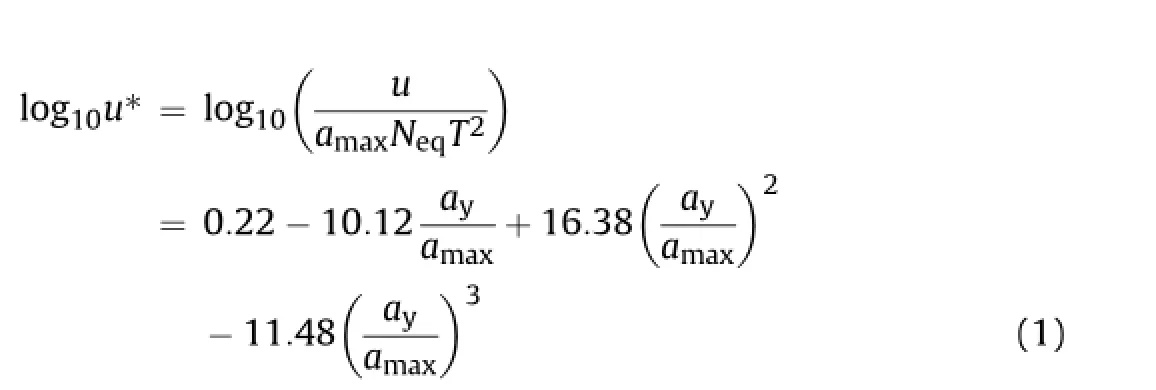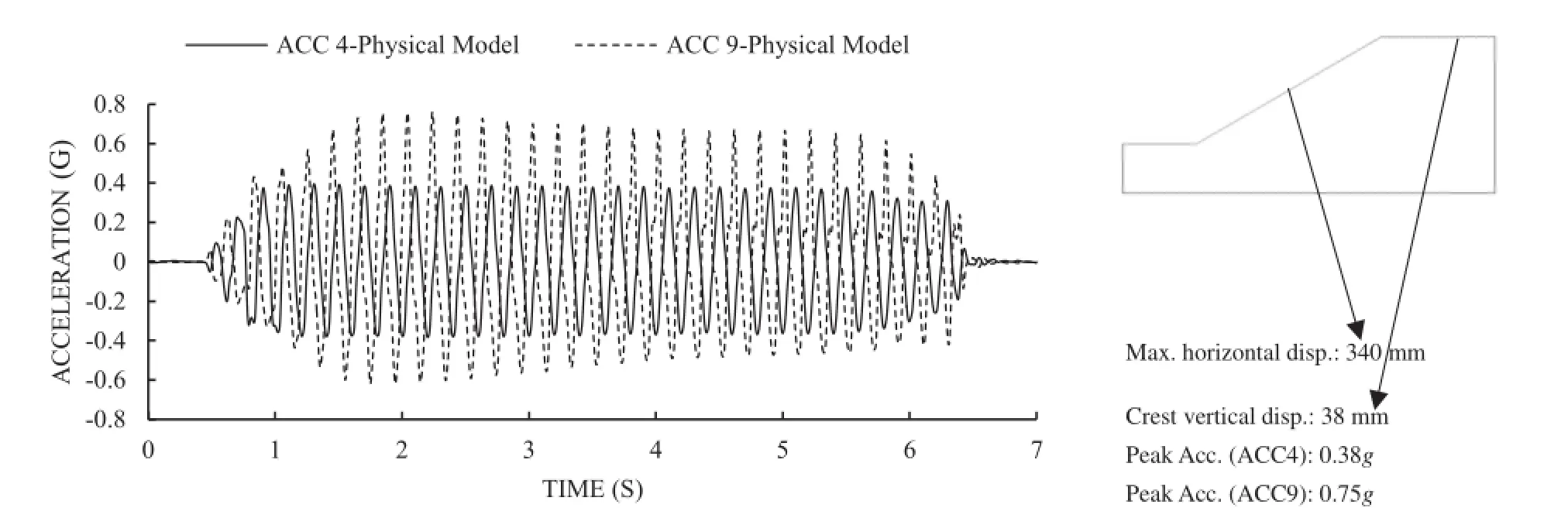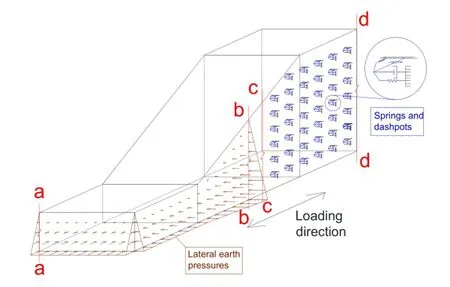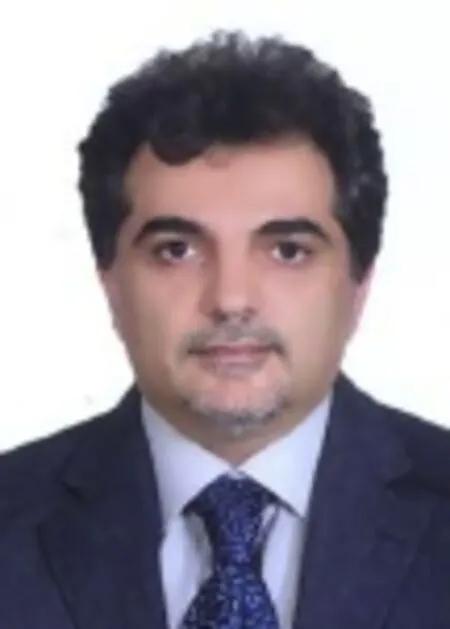On the role of topographic ampli f cation in seismic slope instabilities
Fardin Jafarzadeh,Mohammad Mahdi Shahrabi,Hadi Farahi Jahromi
Civil Engineering Department,Sharif University of Technology,Azadi Avenue,Tehran,Iran
On the role of topographic ampli f cation in seismic slope instabilities
Fardin Jafarzadeh*,Mohammad Mahdi Shahrabi,Hadi Farahi Jahromi
Civil Engineering Department,Sharif University of Technology,Azadi Avenue,Tehran,Iran
A R T I C L E I N F O
Article history:
Received 21 December 2014
Received in revised form
18 February 2015
Accepted 27 February 2015
Available online 17 March 2015
Slope displacement
Surface wave
Numerical modelling
Shaking table test
Topographic ampli f cation
Surface wave generation due to body wave propagation near ground surface has been discussed in the literature.This phenomenon,typically occurring in topographic changing areas,along with its interaction with body waves(SV),decreases precision of formulas for evaluation of slope displacement.This signi f cant fact caused the researchers not only to investigate the combined surface and SV waves motion pattern,but also to consider its effect on structures built on the slopes.In order to reveal the phenomenon,several f nite element numerical studies have been performed by ABAQUS programme.Besides,two physical model slopes simulating the landslide occurrence have been constructed and tested by shaking table device.The results of induced and calculated accelerations obtained by two approaches have been compared and Rayleigh wave generation has been proved.Furthermore,the slope displacements have been calculated by various empirical methods and the results were compared with numerical ones.The results proved that in order to increase the precision of empirical formulas for displacement prediction,surface wave effect should be taken into account.Finally,a concept of“effective depth of sur f cial ampli f cation”is introduced and its effect on dynamic slope stability is analysed.
©2015 Institute of Rock and Soil Mechanics,Chinese Academy of Sciences.Production and hosting by Elsevier B.V.All rights reserved.
1.Introduction
Slope failure,as a result of inertial instability mechanism,is one of the most destructive seismic hazards.Pseudostatic and sliding blocks are the two most famous state-of-the-art procedures used for evaluation of seismic slope failures.Although pseudostatic approach is simple and straightforward,it only determines the potential for initiation of movement along a prede f ned slip surface by giving a safety factor(Kramer,1996).
As permanent deformation analysis(Newmark,1965;Makdisi and Seed,1978)is placed between overly simpli f ed pseudostatic and overly complex stress-deformation approaches(Clough,1960), it has been widely used by engineers in practice(Jibson,2011).The concept and applications of this method,which is based on the analogy of the sliding mass with a moving block on an inclined plane,were comprehensively discussed by many researchers(Lin and Whiteman,1986;Jibson,1993;Kramer and Smith,1997; Rathje and Antonakos,2011).
Though convenient for engineering purposes,permanent deformation procedure for dynamic slope stability evaluation only considers the effect of shear body waves(SV).However,Rayleigh wave is typically generated near soil slopes due to topographic effects on seismic wave propagation.
Uncommon damages have been reported and attributed to topographic ampli f cation of earthquake motions in the 1971 San Fernando earthquake(Boore,1972),1982 Coalinga earthquake (Stewart and Sholtis,2005),1985 Chile earthquake(Celebi,1987) and 1999 Athens earthquake(Gazetas et al.,2002).Irregular geometry of the slope surface and its effect on Rayleigh wave propagation have been the subjects of considerable researches and discussions(Assimaki and Gazetas,2004;Bouckovalas and Papadimitriou,2005).The generated surface waves can signi fcantly affect the response of soil slopes subjected to seismic waves (Uenishi,2010).
By verifying the Rayleigh wave generation in horizontally excited slopes,this paper tries to investigate the effect of surface Rayleigh waves combined with SV body waves generated by earthquake event on soil slopes.Although consequential,this phenomenon has gained less attention by scientists and there are relatively few reported studies in the literature.Herein,f nite element analysis along with shaking table model tests is used to discover the fact.
Accordingly,topographic ampli f cation effect on inertial forces acting on a sliding mass during seismic slope instability has been studied.Finally,the calculated slope displacements are compared with empirically predicted ones,and frequency dependent nature of dynamic slope deformations is recognised.
2.Topography effects and Rayleigh wave generation
Seismic body waves are modi f ed as they reach the earth’s surface due to topographic irregularities.High peak accelerations have been measured at different points along the surface and near the top of ridges,hills and step-like slopes in many earthquakes, such as a ridge in Matsuzaki,Japan(Jibson,1987)in which the average crest peak acceleration was 2.5 times the base acceleration near the toe of the ridge.Re f ection and diffraction are considered to be the main causes of seismic wave ampli f cation near soil slopes.Incident SH waves do not usually generate other wave types(e.g.P,SV and Rayleigh).In fact,SH waves can result in formation of Love waves under site-speci f c conditions which help trapping these waves inside a shallow near-surface layer(e.g.a soft layer upon a dense layer).On the contrary,propagating SV waves near slopes are re f ected in the form of other wave types, especially Rayleigh surface waves.It has also been shown that ampli f cation of SV waves can be much higher than that of SH waves(Assimaki and Gazetas,2004).
As reported by Ohtsuki and Harumi(1983),Rayleigh waves are generated by incident SV waves near the toe of the slope and then propagate along the surface towards the crest of the slope.It has also been stated that the generated Rayleigh waves behind the slope crest can have an amplitude of up to 35%-40%compared to that of the incident waves.However,based on the interaction of various re f ected and diffracted waves,analysis of topographic ampli f cation and deampli f cation is a complicated issue.In fact, patterns of topographic effects rely upon the geometry of the irregularity and upon the types,frequencies,and angles of incident waves(Sanchez-Sesma and Campillo,1993).Consequently,there are a few systematic studies in that context which gave a clear insight to consider the effect of each wave separately.
In any case,it is accepted that Rayleigh surface waves are generated in the vicinity of soil slopes due to diffraction of incident SV waves.Horizontal and vertical displacement amplitudes of Rayleigh waves clearly show that there is an effective depth, approximately equal to the wavelength(λR),to which these waves produce considerable motions.Keeping in mind the fact that the generated Rayleigh waves impose inertial forces on the sliding mass in addition to those by the incident body waves,the signi fcance of the above mentioned surface wave characteristic is magni f ed.Hereafter,the depth beneath a slope surface to which the diffracted Rayleigh waves generated by the incident SV waves result in additional accelerations and inertial forces,is referred to as the“effective depth of sur f cial ampli f cation”.
Within the rigid block theory proposed by Newmark(1965)for evaluation of seismic slope displacements,it was originally assumed that the“failure mass”is rigid;however the materials that comprise most slopes are rather compliant.The extent to which the assumption of rigid“failure mass”remains accurate depends on the wavelength of the input motion compared to the size of the potential sliding mass(Kramer and Smith,1997).For thin failure masses and/or long wavelengths(low input frequencies),motions within the sliding mass are in phase and the effects of failure mass compliance are small.In a different manner, for thick failure masses and/or short wavelengths(high input frequencies),the effect may be signi f cant and the fact that the resulting driving force acting on the potential failure mass is not proportional to the acceleration of each individual point within the mass,clearly shows the importance of frequency-dependent nature of seismic response of slopes.To account for the effect of frequency content of the input motion,Yegian et al.(1991)proposed the following normalised expression for the permanent deformation of slopes by using Newmark’s sliding block analysis and recorded acceleration time histories:

whereu*is the normalized permanent deformation,uis the total relative deformation,ayis the yield acceleration,amaxis the peak acceleration,Neqis an equivalent number of cycles,andTis the predominant period of the input motion.
Within the concept of the effective depth of sur f cial ampli fcation,another critical aspect of frequency-dependent nature of seismic slope failure can be developed.As discussed before,the generated Rayleigh waves increase induced accelerations to a speci f c depth beneath the surface of the slope directly proportional to the predominant wavelength of the input motion(inversely proportional to the predominant frequency).Hence,it can be summarised that the smaller the predominant frequency of the input motion,the larger the area(mass)affected by the generated Rayleigh waves near the slope(Fig.1).This phenomenon leads to greater inertial forces acting on the sliding mass;thus larger induced displacements occur.In fact,this assertion is consistent with the above equation proposed by Yegian et al.(1991).Both of them suggest that the lower predominant period of input motion causes larger displacements.

Fig.1.Effective depth of sur f cial ampli f cation for(a)4 Hz,(b)2 Hz,(c)1 Hz incident SV waves.

Fig.2.Geometry and material characteristics of the prototype slope.
In summary,an important aspect of topographic ampli f cation and Rayleigh wave generation adjacent to ridges,embankments and step-like slopes,the key characteristic of surface waves,is the effective in f uence depth.This fact is another proof for the frequency-dependent nature of seismic slope instabilities.In what follows,some pieces of evidences are presented for this claim by using the results obtained by some numerical and shaking table physical models.
3.Physical model
In order to evaluate the response of a slope subjected to seismic loading,a small-scale 1gshaking table physical test was designed and performed in Geotechnical Earthquake Engineering Laboratory of Sharif University of Technology(Farahi Jahromi et al.,2013).The small-scale slope geometry,material properties and loading characteristics resemble a prototype target slope exposed to an anticipated earthquake excitation in the northwest of Tehran.The following sections introduce the geometry and material characteristics of prototype slope,along with the predicted site-speci f c earthquake.Subsequently,similitude law,its application and physical model results are presented.The small-scale dynamic responses are converted to the full-scale ones and used for numerical model validation.
3.1.Target slope and loading characteristics
The target slope,which has 30°inclination and 8.7 m height,is composed of dense granular material with 15.5 kN/m3unit weight, 30°friction angle,0.6 kPa cohesion,556 MPa maximum elasticity modulus and 0.3 Poisson’s ratio(Fig.2).The computed horizontal yield acceleration of the potential sliding mass(0.110g)will be used in predictive equations of the maximum slope displacement.
The loading characteristics were selected from seismic hazard analysis reports allotted for Tehran with a 975-year return period (5%probability of exceedance in 50 years).The predicted excitations have 0.49gpeak acceleration and 3.8 Hz predominant frequency(TGC,2012).
3.2.Similitude law and small-scale model
As the similitude analysis is of great importance in model dimensions and loading level selection,it is performed based on Iai method(Iai,1989;Iai et al.,2005).By the assumption of the geometrical scaling factor(λ=10),the shear wave velocities of the model and prototype(50 m/s and 375 m/s,respectively),and the similar soil densities(λρ=1),λεand model dimensions were calculated.Table 1 summarises the assumptions of similitude calculations.
A small-scale dynamic 1gshaking table test was performed on a slope model composed of non-cohesive granular material(Babolsar coastal sand).The poorly graded sand has less than 3%f nes,1420-1750 kg/m3density and 5%moisture in the laboratory.For model preparation,the air pluviation method was used and a pouring height of 70 cmwas calibrated and used in order to reach the target density and uniformity.A rigid box(300 cm×100 cm×150 cm (L×W×H))composed of steel pro f le and plates was used as a soil container.Besides,a Plexiglas plate installed on one side of the box allowed the slope deformation to be monitored(Farahi Jahromi et al.,2013).
The slope deformations were visually measured from displacements of plaster strips poured in each 10 cm layer adjacent to Plexiglas plate(Fig.3).The properties,physical characteristics and instrumentation of the slope model are summarised in Table 1. According to Seed approach(Kramer,1996)and similitude calculations,the sandy slope was subjected to an arti f cial sinusoidal loading of 25 cycles with 0.32gamplitude(65%of the anticipated peak amplitude)and 5 Hz frequency.
Dynamic slope responses were recorded by accelerometers and LVDTs installed in the slope.The maximum horizontal displacement of the sliding mass,vertical displacement of slope crest and acceleration time histories of slope’s toe(accelerometer ACC4)and crest(accelerometer ACC9)were used for empirical analysis and large-scale f nite element model veri f cation(Fig.4).
4.Full-scale f nite element models
The full-scale prototype slope was simulated and analysed by the f nite element based ABAQUS programme.The slope material properties were selected as those assumed for the target slope (prototype parameters indicated in Table 1).In order to make the numerical model more comparable to actual f eld conditions,lateral earth pressures and absorbent boundaries were assigned to the sides of the slope(Fig.5).Absorbent boundaries were de f ned by springs and dashpots at nodal points and the corresponding stiffness and damping coef f cients were calculated(Meek and Wolf, 1992).The above-mentioned coef f cients are functions of material stiffness and in f uence area in each node.

Table 1Characteristics and instrumentation of the physical model.
Modulus reduction curves were used to de f ne the nonlinear behavior of the soil.EPRI guidelines(EPRI,1993)for sandy soils were used to determine the cyclic shear strain dependency of elastic moduli at various depths.Moreover,low-strain stiffness(E0) in non-cohesive soils is known to be directly proportional to the vertical effective stress by the following equation(Das,1985):


Fig.3.Constructed physical model of slope.
whereE1andE2are the stiffness moduli at two different points with vertical stresses ofσ1andσ2,respectively.As a result,the low-strain elasticity modulus increases with depth.Fig.6 presents combined effects of cyclic shear strain and vertical effective stress on Young’s modulus for various depths of the numerical model.According to Ishibashi and Zhang(1993),cyclic shear strain-dependent material damping was also assigned to the sandy soil.
4.1.Results and validation

4.2.Evidence for Rayleigh wave generation
Geometric irregularities are proved to in f uence incident waves and generate Rayleigh waves near a slope subjected to SV waves. Herein,some indications of such effect in both physical and numerical models are presented and discussed.
It is interesting to consider the frequency response of recorded accelerations in both physical and numerical models.As predicted, the highest amplitudes in smoothed fast Fourier transforms(FFTs) of accelerometer ACC4 in the physical test and the numerical model are observed at the loading frequencies of 5 Hz and 3.8 Hz, respectively(Figs.8a and 9a).However,Fig.8b shows that in accelerometer ACC9,secondary waves with considerable amplitudes at higher frequencies than that of the input motion are generated(e.g.10 Hz,15 Hz and 20 Hz).A similar observation is shown in Fig.9b which is related to the recorded acceleration in ACC9 in the numerical model.The variation in Fourier spectrum, along with high ampli f cations in the slope crest,is a sign of Rayleigh wave generation caused by diffraction of incident SV waves.
As discussed before,an important characteristic of Rayleigh waves is the depth to which they penetrate under the surface of propagation.This depth is approximately equal to their wavelength.Therefore,for waves with a lower predominant frequency (longer wavelength),ampli f cations due to Rayleigh wave generation in f uence the subsurface material to a greater depth.This concept can be referred to as the“effective depth of sur f cial ampli f cation”,and has gained less attention in analyses of seismic slope stability.Using the veri f ed large-scale numerical model and input motions of constant amplitudes(0.32g),a frequency analysis was conducted and the model was shaken to various frequencies of 1-10 Hz.Fig.10 graphically shows computed accelerations inmodels with exciting frequencies of 1 Hz,3.8 Hz and 10 Hz.The wave fronts of Rayleigh waves for each model are speci f ed with circles.The depths to which horizontal accelerations were increased clearly show the in f uence depth of surface waves.This evidence can better prove the frequency-dependent nature of topographic(geometric)ampli f cations acting on any slope,and in fact,on a given sliding mass within the slope.The schematic view in Fig.10 indicates that input motions with greater wavelengths can have more destructive effects on slopes,not only as a consequence of in phase driving forces acting on the sliding mass(Kramer and Smith,1997),but also as a result of greater in f uence depths of generated Rayleigh waves.

Fig.4.Typical dynamic response of the physical model.

Fig.5.Boundary conditions assigned to the numerical model.For clarity,lateral earth pressures are sketched between sections a-a to b-b,and springs/dashpots between sections c-c to d-d.

Fig.7.Typical dynamic response of the large-scale numerical model.

Fig.9.Smoothed fast Fourier transform of ACC4 and ACC9 in the full-scale numerical model.

Fig.10.Horizontal accelerations(m/s2),in f uence depth of Rayleigh waves generated near slopes subjected to input motions with frequencies of(a)10 Hz,(b)3.8 Hz and(c)1 Hz.

Fig.11.Maximum horizontal displacement of the slope subjected to input motions with various loading frequencies.
4.3.Deformation analyses
Full-scale f nite element model displacement results are compared with those obtained by some classical permanent deformation analyses.It is important to note that most of these methods assume the response to be frequency-independent. However,as discussed earlier,there seems to be an elapsed connection between the frequency content of an input motion and displacement response of an earthquake induced landslide.The results of frequency analyses support the idea that lower frequency (higher wavelength)excitations lead to greater horizontal displacements(Fig.11).
Predicted horizontal displacements of Makdisi-Seed method (Makdisi and Seed,1978)are in the range of 95-606.5 mmwith the average value of 173 mm(for all input frequencies).Similarly, Ambraseys-Menu formula(Ambraseys and Menu,1988)anticipated a value of 244.8 mm.When compared to the results of the numerical models,these estimates mostly underestimate the actual displacements.
On the contrary,Yegian et al.(1991)approach seems to better re f ect the effects of frequency content in earthquake induced displacements(Fig.11).Nonetheless,it seems to greatly overestimate the permanent displacement of a slope when subjected to low frequency loadings(lower than 2 Hz).
5.Conclusions
The earthquake induced displacement of a sliding mass is an important parameter used to assess the seismic performance of slopes(Rathje and Antonakos,2011).Commonly,most of the predictive models use the bedrock peak acceleration for slope’s horizontal displacement calculations.Some of these models modi f ed their predictions by taking acceleration ampli f cations into account. Nevertheless,incident body wave diffraction near slope surface is neglected,a phenomenon which converts the propagating body waves in the form of Rayleigh surface waves and greatly in f uences the slope’s dynamic response pattern.
This paper evaluates the signi f cance of the“effective depth of sur f cial ampli f cation”and its in f uence on the seismic performance of slopes.As the in f uence depth is directly proportional to wavelength,the frequency-dependent nature of seismic slope instabilities seems indispensable.
On this subject,a 1gshaking table test and numerical analyses are performed to examine the generation of surface waves near the slope.Then,the impact of predominant frequency and effective depth of the input motion on permanent horizontal displacements of the slope is studied.The following conclusions can be drawn:
(1)Topographic ampli f cation can greatly increase the induced accelerations on the surface of a slope and most signi f cantly on its crest.
(2)Generated Rayleigh waves near the slope toe propagate upwards to the slope crest,where they meet preceded Rayleigh waves produced on the horizontal surface of the crest.
(3)The accuracy of methods to predict the earthquake induced permanent deformation of a slope can be increased by considering the topographic ampli f cation phenomenon.
(4)Based on the fact that wavelength affects the in f uence depth of surface waves,and it itself is totally dependent on the frequency content of the wave,seismic slope instabilities undoubtedly have frequency-dependent nature.
It is important to note that the classical procedures of seismic permanent deformation assessment of slopes are best performed if the average horizontal acceleration induced in the sliding mass is implemented(by considering both incident and diffracted/ref ected waves).However,exact prediction of such quantity seems dif f cult to be achieved,since it is affected by many parameters such as the geometry of the irregularities and the types,frequencies,and angles of incident waves.
Con f ict of interests
The authors wish to con f rm that there are no known con f icts of interest associated with this publication and there has been no signi f cant f nancial support for this work that could have in f uenced its outcome.
Acknowledgements
The authors deeply appreciate Tehran Gas Company(TGS)’s authorities who introduced the research project and f nancially supported the physical tests and numerical modelling expenses. Also they thank Dr.Davoudi’s instructions who guided the research group as the TGS’s representative.
Ambraseys NN,Menu JM.Earthquake-induced ground displacements.Earthquake Engineering and Structural Dynamics 1988;16(7):985-1006.
Assimaki D,Gazetas G.Soil and topographic ampli f cation on canyon banks and the 1999 Athens earthquake.Journal of Earthquake Engineering 2004;8(1):1-43.
Boore DM.A note on the effect of simple topography on seismic SH waves.Bulletin of the Seismological Society of America 1972;62(1):275-84.
Bouckovalas GD,Papadimitriou AG.Numerical evaluation of slope topography effects on seismic ground motion.Soil Dynamics and Earthquake Engineering 2005;25(7-10):547-58.
Celebi M.Topographic and geological ampli f cations determined from strongmotion and aftershock records of the 3 March 1985 Chile earthquake. Bulletin of the Seismological Society of America 1987;77(4):1147-67.
Clough RW.The f nite element method in plane stress analysis.In:Proceedings of the 2nd Conference on Electronic Computation.Pittsburgh,USA:ASCE Structural Division;1960.
Das BM.Advanced soil mechanics.McGraw-Hill;1985.
Electric Power Research Institute(EPRI).Guidelines for determining design basis ground motions.Final Rep.No.TR-102293.Palo Alto:California;1996.
Farahi Jahromi H,Joshaghani M,Sehi-Zadeh M,Youse f S.Comparison of dynamically-induced experimental slope deformations with numerical sliding block theory.In:Proceedings of the 5th International Young Geotechnical Engineering Conference;2013.Paris,France.
Gazetas G,Kallou PV,Psarropoulos PN.Topography and soil effects in theMs5.9 Parnitha(Athens)earthquake:the case of Adames.Natural Hazards 2002;27(1-2):133-69.
Iai S.Similitude for shaking table tests on soil-structure-f eld model in 1ggravitational f eld.Soils and Foundations 1989;29(1):105-18.
Iai S,Tobita T,Nakahara T.Generalised scaling relations for dynamic centrifuge tests.Geotechnique 2005;55(5):355-62.
Ishibashi I,Zhang X.Uni f ed dynamic shear moduli and damping ratios of sand and clay.Soils and Foundations 1993;33(1):182-91.
Jibson RW.Summary of research on the effects of topographic ampli f cation of earthquake shaking on slope stability.Menlo Park,CA:US Geological Survey Open-File Report;1987.p.87-268.
Jibson RW.Predicting earthquake-induced landslide displacements using Newmark’s sliding block analysis.Transportation Research Record 1993;1411:9-17.
Jibson RW.Methods for assessing the stability of slopes during earthquakes-A retrospective.Engineering Geology 2011;122(1-2):43-50.
Kramer SL.Geotechnical earthquake engineering.Prentice-Hall;1996.
Kramer SL,Smith MW.Modi f ed Newmark model for seismic displacements of compliant slopes.Journal of Geotechnical and Geoenvironmental Engineering 1997;123(7):635-44.
Lin JS,Whiteman RV.Earthquake induced displacements of sliding blocks.Journal of Geotechnical Engineering 1986;112(1):44-59.
Makdisi FI,Seed HB.Simpli f ed procedure for estimating dam and embankment earthquake-induced deformations.Journal of Geotechnical Engineering 1978;104(7):849-67.
Meek JW,Wolf JP.Cone models for homogeneous soil,I.Journal of Geotechnical Engineering 1992;118(5):667-85.
Newmark NM.Effects of earthquakes on dams and embankments.Geotechnique 1965;15(2):139-60.
Ohtsuki A,Harumi K.Effect of topography and subsurface inhomogeneities on seismic SV waves.Earthquake Engineering and Structural Dynamics 1983;11(4): 441-62.
Rathje EM,Antonakos G.A uni f ed model for predicting earthquake-induced sliding displacements of rigid and f exible slopes.Engineering Geology 2011;122(1-2): 51-60.
Sanchez-Sesma M,Campillo M.Topographic effects for incident P,SV,and Rayleigh waves.Tectonophysics 1993;218(1-3):113-25.
Stewart JP,Sholtis SE.Case study of strong ground motion variations across cut slope.Soil Dynamics and Earthquake Engineering 2005;25(7-10):539-45.
Tehran Gas Company(TGC).Geological and seismological reports of Tehran.2012. Tehran,Iran.
Uenishi K.On a possible role of Rayleigh surface waves in dynamic slope failures. International Journal of Geomechanics 2010;10(4):153-60.
Yegian MK,Marciano E,Ghahraman VG.Earthquake-induced permanent deformations:probabilistic Approach.Journal of Geotechnical Engineering 1991;117(1):35-50.

Dr.Fardin Jafarzadehis an associate professor and head of the Geotechnical Engineering Group of Civil Engineering Department at Sharif University of Technology,Iran.His research interests include soil dynamics,geotechnical earthquake engineering,buried pipelines,earth f ll dams, shaking table modelling,unsaturated soil mechanics,laboratory testing,constitutive modelling,ground improvement,etc.
*Corresponding author.Tel.:+98 21 6602 2727.
E-mail address:fardin@sharif.edu(F.Jafarzadeh).
Peer review under responsibility of Institute of Rock and Soil Mechanics,Chinese Academy of Sciences.
1674-7755©2015 Institute of Rock and Soil Mechanics,Chinese Academy of Sciences.Production and hosting by Elsevier B.V.All rights reserved.
http://dx.doi.org/10.1016/j.jrmge.2015.02.009
 Journal of Rock Mechanics and Geotechnical Engineering2015年2期
Journal of Rock Mechanics and Geotechnical Engineering2015年2期
- Journal of Rock Mechanics and Geotechnical Engineering的其它文章
- Laboratory study on the mechanical behaviors of an anisotropic shale rock
- Thermo-mechanical constitutive modeling of unsaturated clays based on the critical state concepts
- Monitoring result analyses of high slope of f ve-step ship lock in the Three Gorges Project
- UCIMS:Advances in geotechnical construction and performance monitoring
- Liquefaction evaluation of dam foundation soils considering overlying structure
- Improvement parameters in dynamic compaction adjacent to the slopes
